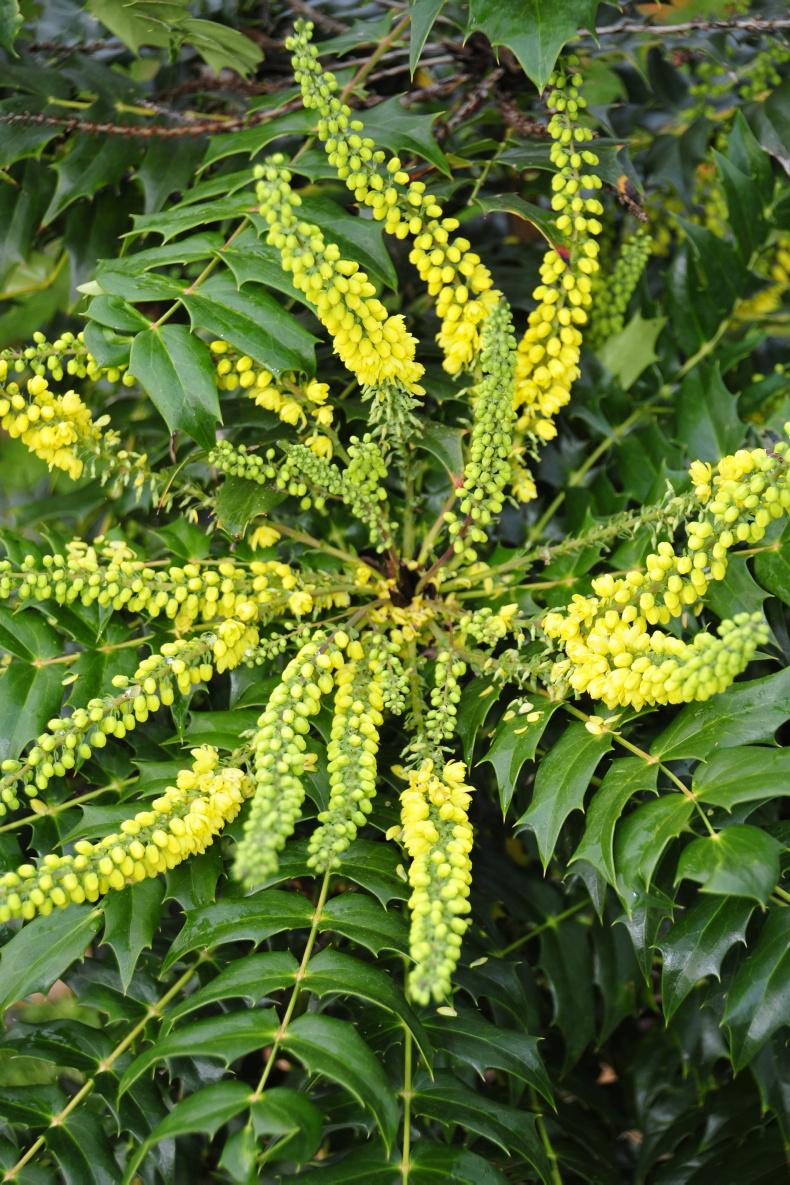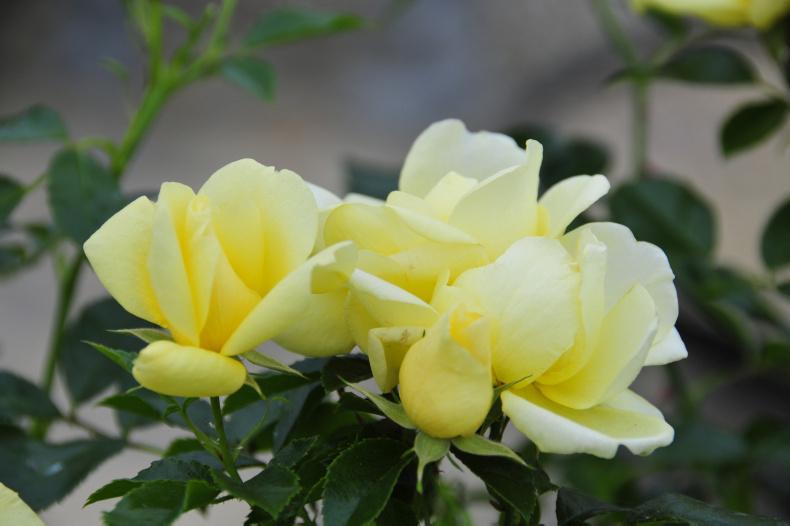Mahonia is very distinctive in the form of its foliage and stems. The evergreen leaves are divided into two matching rows of leaflets, each leaflet defended by small spines, resembling holly leaves. The number of leaflets on each leaf varies according to species, some have nine or 13 leaflets, some with 19, and one species has 41 leaflets, giving it an almost fish bone-like look.
The number of leaflets is always an odd number, because there is a single leaflet at the tip of the leaves. The leaves are carried in rounded rosettes at the top of the stems, like a flat shuttlecock shape.
The stems come up straight and upright from ground level, also in a distinctive fashion. Though they never grow very thick and look a bit flimsy, the slender, tall stems are quite robust.
On each of these stems, at the centre of the leaf rosette, narrow sprays of small, yellow flowers are carried. These open from rounded green buds, turning yellow when they swell, and opening as tiny daffodil-shaped flowers. The flowers are not only daffodil-like in shape, but have a sweet daffodil scent too. The scent of the flowers is best appreciated when some of the flower stems are brought indoors, where they will last in water for a few days.
The flowers open in sequence, extending flowering from mid-autumn to late winter. They look best in late autumn and early winter and become a bit bedraggled as winter weather takes its toll. The flowers are often followed by small, blue-black berries with a waxy coat, carried along the straight flower stems, but these, while pretty, are too dark to offer much ornamental value.
There are Asian and American species. The lovely mahonia japonica is widely grown, native to China, not to Japan as the name implies. It makes a fine bush to about two metres tall and at least as much across. It needs space and provides good greenery for winter effect. Some of the leaves may turn red for winter, which is a nice extra feature.
A selection from the species, the named variety Bealei has slightly blue-green leaves and holds its shorter flower spikes more upright. Charity is a hybrid of two Chinese species with lots of flower spikes, upright at first and then arching with the weight of flowers as they open. Winter Sun is a lovely variety that has arching, bright yellow flower spikes. Lionel Fortescue has upright, bright yellow flowers, on stems up to 40cm long, twice as long as others.
Much taller, standing at well over three metres, mahonia lomariifolia is the tallest species grown in gardens. It is the one with 41 leaflets per leaf and looks very dramatic, though the flowers can hardly be seen.
It has stout stems with fissured bark. A new species hybrid called Soft Caress has appeared in recent years and has long, narrow leaflets, giving it an almost ferny appearance, and small, yellow flowers. It seems to be reasonably hardy. The American species mahonia aquifolium, the Oregon grape, carries rounded clusters of deep yellow flowers in spring.
Mahonia likes good soil, but will grow in any ordinary soil that is not wet and soggy, and it survives well in dry soil, though its foliage will not be as luxuriant. It flowers best in good light, but can take a fair degree of shade, being native to woodland and rocky places. Mahonia can become tall and ungainly, but can be cut back hard in spring, and will re-sprout well. CL
Rough times for roses
Rose bushes are sometimes great value for a late show of flowers in a favourable year, occasionally well into early winter. This year, although temperature levels have been very good at times and there was little frost until November, roses were badly tossed about by strong winds and heavy rain. Roses are not up to much rough treatment and late flowers mostly have been shed.
With long stems, now largely bare of leaves, rose bushes can be rocked in the ground by winter gales and this can affect growth, and even survival. To lessen the height of the stems, rose bushes and repeat-flowering climbers can be pruned now or any time until February. Early pruning brings earlier flowering and a better tailend of flowers next autumn. Clear the ground of weeds and firm the soil around any loose bushes.
Trees, shrubs and roses
Now is a good time to move deciduous trees or shrubs that need more room, or are in the wrong position. Most kinds move successfully. Roses establish well from November planting and the choice of kinds in garden centres is greater now. At planting, use some mycorrhizal treatment.
Flowers
There is still time to plant up a few spring bedding plants and winter containers, close to a front door or gateway. It is much easier to make a splash in winter with a couple of containers than in summer, when there are so many competing floral attractions. Plant perennial flowers.
Fruit, vegetables and herbs
Continue to tidy the vegetable garden and make sure to knock back weeds, not letting them grow over winter. Perennial herbs can be lifted, divided and re-planted, or bought and planted. Fruit trees and bushes can be planted now, using freshly lifted plants that take root much better.
Lawn
The lawn should be mowed if the ground is not soggy. Grass growth was still active recently and mowing should continue as long as possible. Sulphate of iron should be applied if there is a lot of moss, as it will develop even more during the damp months. Trim lawn edges at borders.
Greenhouse and house plants
Discontinue feeding of house plants. Ensure that you are not over-watering house plants and allowing them to stand in a saucer of water. The roots will rot now that growth has markedly declined. Make sure too that the plants are not too close to a source of heat, such as a radiator.






 This is a subscriber-only article
This is a subscriber-only article










SHARING OPTIONS: